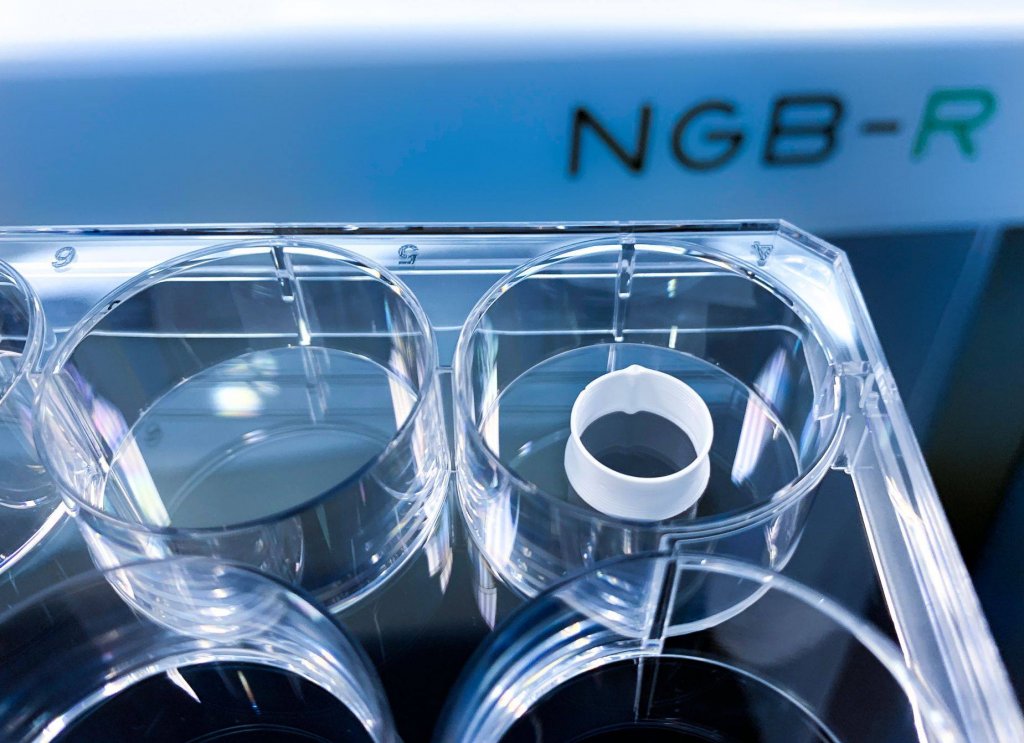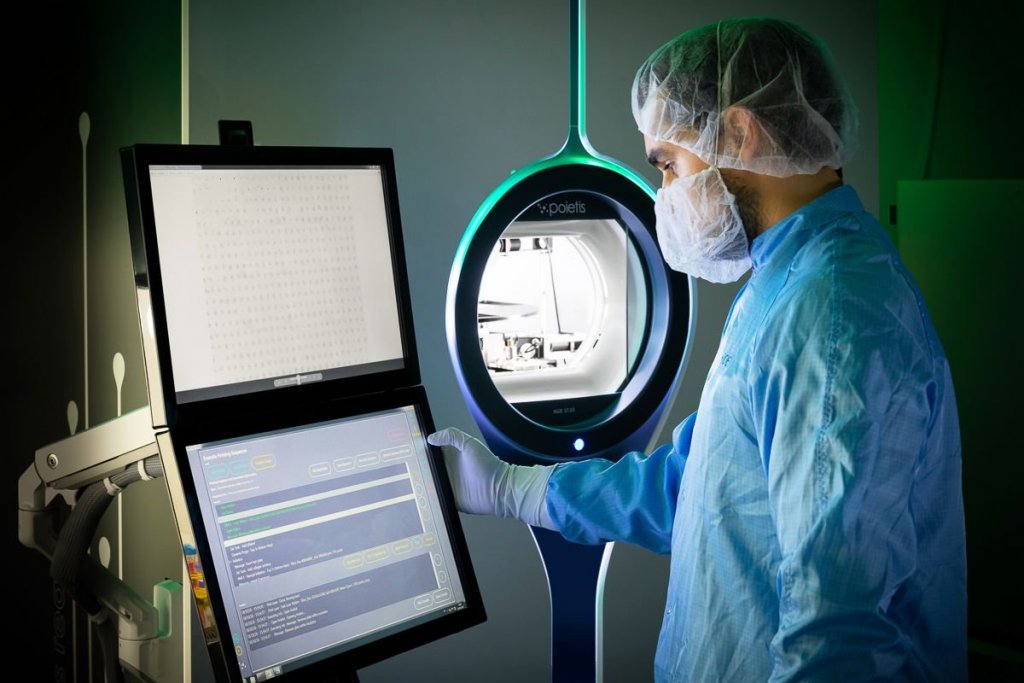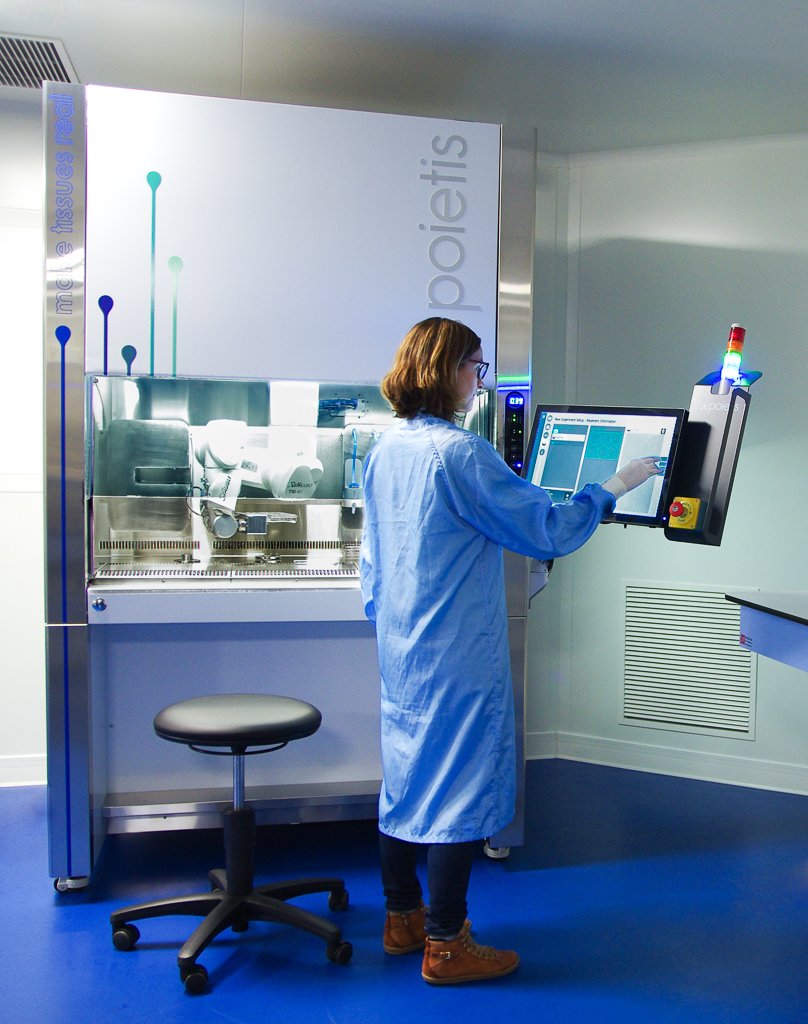 In 2014, French startup Poietis developed a unique technology for the bioprinting of living tissue. Unlike conventional approaches to tissue engineering or extrusion bioprinting, their promising 4D laser-assisted system allows cells to be positioned in three dimensions with micrometric resolution and precision. Their aim is to design living tissue using cells and biomaterial that researchers can apply to manufacture products for regenerative medicine, preclinical research, and cosmetic uses–making a big difference in the testing of cosmetics and consumer products. This is especially relevant considering that the debate about animal research and testing is a hot topic everywhere.
In 2014, French startup Poietis developed a unique technology for the bioprinting of living tissue. Unlike conventional approaches to tissue engineering or extrusion bioprinting, their promising 4D laser-assisted system allows cells to be positioned in three dimensions with micrometric resolution and precision. Their aim is to design living tissue using cells and biomaterial that researchers can apply to manufacture products for regenerative medicine, preclinical research, and cosmetic uses–making a big difference in the testing of cosmetics and consumer products. This is especially relevant considering that the debate about animal research and testing is a hot topic everywhere.
In 2013, the European Union passed legislation that instituted a ban on the sale of animal-tested products in the continent, followed by other countries like India, Israel, Norway, Taiwan, and New Zealand, while the practice is being contested in the US and other markets where it is still legal. Companies like Poietis are using 3D bioprinting technology to develop a more cost-effective, versatile, and ethical way for companies to go about testing. But that’s just one of their advantages, along with the development of the multimodal bioprinting platform Next Generation Bioprinting (NGB); the creation of Poieskin, commercial bioprinted human tissue; and the NGB-C system for clinical applications.
In 2012 and after 20 years of professional experience in the biotech MedTech sector, the co-founder of Poietis, Bruno Brisson, met Fabien Guillemot (the other co-founder of the company and CEO).
“Guillemot was questioning himself about the valorization of a technology he had developed with his team at INSERM and the Tissue Bioengineering Lab of the University of Bordeaux: laser-assisted bioprinting, and I had created a consulting firm focused on business development in life sciences, so it was the right time to get together and share our vision of what could be done with this technology and what we wanted to do in the future,” revealed Brisson in an interview with 3DPrint.com. “We wanted to set-up an innovative company that could take the technology to clinics, provide new therapeutic solutions to the market of tissue and organ repairs, and help develop new advanced therapies.”
Regulatory pressure everywhere to ban animal testing and concerns about animal experiments to model human health, along with the animal experiment ban for the cosmetics industry in Europe, has resulted in an evergrowing demand for in vitro alternatives. This is one of the reasons why Poeitis founders decided to first focus on in vitro applications for the skin tissue market. To do so, they hired an interdisciplinary team of physicists, software developers, biologists, and pharmacists to bring their expertise to the areas of laser and optics, microfluidics, machine learning, cell biology, and tissue engineering as well as cell therapy manufacturing. Their bioprinted in vitro models are used in dermo-cosmetics, but also in pharmaceutical research, for example, to evaluate the mechanism of actions for validating new drug candidates in the case of disease models.
The company, headquartered in Pessac, France, soon developed partnerships with other firms. In 2015, chemical giant BASF signed an agreement with Poietis to 3D print skin for cosmetic testing purposes, using the 3D laser-assisted bioprinting technology to further develop its Mimeskin tissue, which is one of the closest equivalents to the original physiological equivalents of real human skin. After their success, they moved towards improving the skin models by increasing structure complexity and adding new cell types. Almost around the same time, Poietis became associated with the L’Oréal group and began researching how to bioprint hair as a viable solution for people suffering from alopecia.
“Poietis has been able to enter into industrial partnerships quickly after inception, like with pharma company Servier to develop a 4D bioprinted liver model that could predict liver toxicity of drugs better than current methods,” Brisson said. “As well as other collaborations with the academic sector, such as with the Catholic University of Leuven (KU Leuven), in Belgium, on cartilage. As well as through two European Consortium EU H2020 FET-Open Pan3DP projects, one to biomimic developmental processes to fabricate 3D bioprinted pancreatic tissue units that allow sustained cell viability, expansion and functional differentiation ex vivo and another in neurobiology.”

A 16 layer 3D structure designed with Poietis CAD software and created with the NGB-R’s extrusion process
At Poietis, the core of their expertise is the high-resolution laser-assisted bioprinting, after which they have based and developed their Next-Generation Bioprinting (NGB) platform, which they claim gives tissue engineers and researchers greater freedom in the choice of biomaterials and hydrogels, and greater versatility in their research and development. The two bioprinters currently marketed are the NGB-R Bioprinter (commercialized for research applications) and the NGB-C Bioprinter (a clinical-grade, GMP-compliant system dedicated to clinical applications and challenges of industrial manufacturing of implantable tissues).
“Today our NGB-R consists of a platform (CAD + bioprinter) allowing to control the 3D organization of cells with cell resolution. It is an automated, robotized bio-printing platform guaranteeing reproducible tissue manufacturing and accelerating translation to clinical phases. Moreover, it is a single multimodal platform embedding the three main bioprinting technologies–including laser-assisted bioprinting– and allowing researchers to work with a variety of cell types but also to assess the printability and biocompatibility and work with a number of bioinks. Finally, we can control and monitor the formation of organoids through a controlled deposition of 2D cells (one or more cell types) and bioprint large objects such as cell aggregate of spheroids,” said Brisson.
At Poietis, they talk about the process as a form of 4D printing, claiming that “the approach consists in programming self-organized tissue (cells and extracellular matrix) that evolve in a controlled way until specific biological functions emerge”. So that by analyzing tissue evolution during maturation, they are able to optimize the initial tissue architecture defined by a CAD tool in order to improve the functionality of the printed tissues and guarantee that they are manufactured in the most reliable way. The company is developing dedicated software to program tissue self-organization, which means that they will anticipate the evolution of the bioprinted construct with time. And time plays a big role in 4D bioprinting, something which makes their system quite unique.
We have talked about 4D printing before, which means creating 3D objects that change their shape over time in response to stimuli such as heat, moisture or light, making structures that easily adapt to their environment. On the hardware side, Poietis applies its laser-assisted bioprinting technique using laser pulses programmed to be sent every nanosecond, used to deposit microscopic droplets of cell-laden ink on a cartridge (composed of an ink film spread on a glass plate). Via the software, they can control the physical conditions of the ejection (like energy and viscosity), as well as the droplet volume to near picolitre accuracy. According to the company, the process can achieve 20 µm resolution at speeds of 10,000 droplets a second, resulting in cell concentrations of 100 million cells/mL and 100 percent cell viability.
The process led Poietis to develop Poieskin, a bioprinted skin made up of a human full-thickness skin model that is entirely produced by 3D bioprinting.
“Poieskin® consists of a dermal compartment composed of primary human fibroblasts embedded in a collagen I matrix overlaid by a stratified epidermis derived from primary human keratinocytes. Its biofabrication benefits from the latest advances in 3D bioprinting technology. The high precision and resolution of Poietis laser-assisted bioprinter, as well as the embedded in-line monitoring systems, able to control the quality of each bioprinted layer and hence to manufacture controlled 3D cell structures and reproducible tissue models. It can be used for pharmacological and cosmetic research (like testing the effects of a drug on a real human skin equivalent), so at the moment, we are mainly selling the innovation to CROs (Contract Research Organisations), academic laboratories and dermo-cosmetic firms.”
With a tissue engineering market worth an estimated 15 billion dollars, and growing, the bioprinting industry is getting a lot of attention, and companies all over the world are taking notice. Poietis has three patents covering its bioprinting technology, and a recent financing round of five million euros to accelerate technological developments that could lead to the first implantation of a bioprinted tissue into patients starting in 2021, and is well is on its way to becoming one of the innovative European startups to look for during the coming years.
Brisson explained that “the future of tissue engineering will be based on technologies capable of studying the growth of connective tissue or organs but also to produce replacement tissue for implantation into the body. We consider that tissue engineering will be the next revolution in healthcare, using the patient’s own cells to build or rebuild organs.”
“Poietis is still working a lot on skin bioprinting, especially for in vitro applications based on Poieskin® as a platform of complexification. But the company is also developing the NGB-C system to meet future clinical needs of our partners, which is based on the same core technology as NGB-R, but NGB-C will face the requirements of translational research and the challenges associated with the industrial manufacturing of implantable tissues. Right now we are at a turning point as we started different projects with clinical aims, the first and most advanced is on the skin by targeting certain wound indications with a goal of a first-in-man within two years (clinical trials). We also have two other projects in cardiology and for all of these, we already have clinical collaborators.”
The bioprinting technology available at Poietis is the result of innovative research, and over a ten-year time lapse at Inserm and the University of Bordeaux, resulting in wins at the iLab competition in 2014, the World Innovation Challenge Phase II in 2017, and most recently the EY Disruptive Strategy Award. But Poietis is lucky to be among a forward-looking bioprinting environment. The groundbreaking technology has seen some challenges over the last few years, and not every country has made efforts to help with its development.
According to Brisson, “France is certainly helping the emergence of these technologies with agencies such as BpiFrance, the French Public Investment Bank and a one-stop-shop for entrepreneurs and different subsidies for innovation at regional and national levels. That being said initiatives at the European level will certainly have a bigger impact, such as Restore–a very large action for advanced therapies at the EU level–, as well as the support of the European Medicines Agency.”
In many ways, Poietis has begun to change the future of regenerative medicine and the manufacture of living tissue. With uses in cosmetics and drug testing that are quickly becoming an alternative to animal testing everywhere, the company is fast to becoming a household name in France, pushing the advances of their innovation into clinical labs and giving researchers more tools to efficiently surpass the limits of bioprinting. We’ll have to wait until 2021 before the first implantation of bioprinted tissue into patients become a reality.
Subscribe to Our Email Newsletter
Stay up-to-date on all the latest news from the 3D printing industry and receive information and offers from third party vendors.
Print Services
Upload your 3D Models and get them printed quickly and efficiently.
You May Also Like
Reinventing Reindustrialization: Why NAVWAR Project Manager Spencer Koroly Invented a Made-in-America 3D Printer
It has become virtually impossible to regularly follow additive manufacturing (AM) industry news and not stumble across the term “defense industrial base” (DIB), a concept encompassing all the many diverse...
Inside The Barnes Global Advisors’ Vision for a Stronger AM Ecosystem
As additive manufacturing (AM) continues to revolutionize the industrial landscape, Pittsburgh-based consultancy The Barnes Global Advisors (TBGA) is helping shape what that future looks like. As the largest independent AM...
Ruggedized: How USMC Innovation Officer Matt Pine Navigates 3D Printing in the Military
Disclaimer: Matt Pine’s views are not the views of the Department of Defense nor the U.S. Marine Corps Throughout this decade thus far, the military’s adoption of additive manufacturing (AM)...
U.S. Congress Calls Out 3D Printing in Proposal for Commercial Reserve Manufacturing Network
Last week, the U.S. House of Representatives’ Appropriations Committee moved the FY 2026 defense bill forward to the House floor. Included in the legislation is a $131 million proposal for...






































